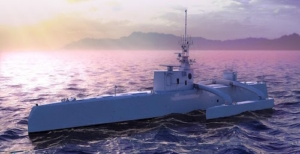Are Crewless Ships in the Navy’s Future?

By Debbie Gregory.
Autonomous vehicles are becoming more common by the day, and new autonomous ships could change the future of the Navy.
To that end, a team of senior Navy officials is examining the feasibility of turning over some jobs to unmanned vessels and submarines.
Naval analyst Bryan Clark of the Center for Strategic and Budgetary Assessments and other outside experts have participated in a series of “fleet architecture studies” led by the office of the chief of naval operations. Their findings will shape the future fleet.
The review could be a potential turning point in the modernization of the Navy’s fleet. Those in the robotics industry are optimistic that the fleet studies will open the door for autonomous systems to become mainstream.
The Defense Advanced Research Projects Agency has offered a glimpse into the possible future of crewless ships, deploying a 132-foot autonomous trimaran off the coast of San Diego.
The Sea Hunter is able to operate on its own, using modern technology such as radar, sonar, and global positioning systems to navigate. Sea Hunter will be able to cut through the waves at speeds of up to 30 miles per hour. The ship cost $120 million to develop, although engineers say each ship would likely cost around $20 million to produce.
“You now have an asset at a fraction of the cost of a manned platform,” said Rear Admiral Robert Girrier, who directs the Navy’s unmanned warfare systems program.
“Sea Hunter is designed to operate for extended periods at sea with no person on board and only sparse supervisory control,” according to Leidos, the contractor firm that built the ship for DARPA.
While initial tests require a pilot on board the ship, later tests are planned to have no human operators. The two-year program is funded by DARPA and the Office of Naval Research. Upcoming tests will dig deeper into the performance of sensors, the vessel’s autonomy suite and compliance with maritime collision regulations.
Military Connection salutes and proudly serves veterans and service members in the Army, Navy, Air Force, Marines, Coast Guard, Guard and Reserve, and their families.

















